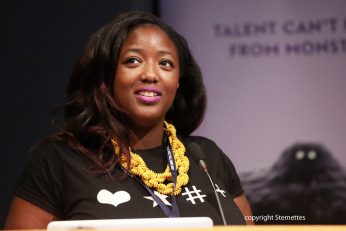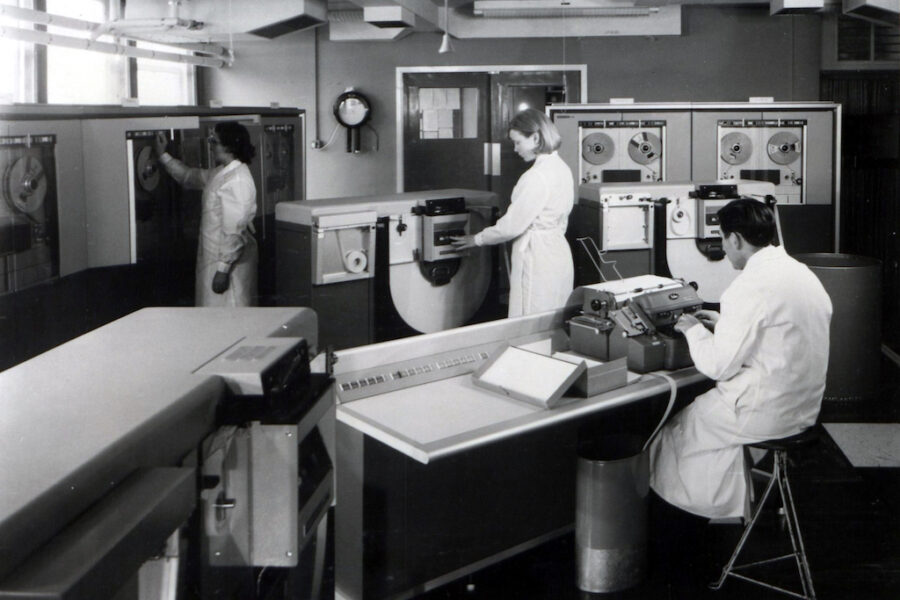Analysing the oral histories of three female leaders in Tech born across nearly 60 years, Sophia Ahmed, a volunteer for AIT, who graduated two years ago in humanities, offers her assessment of some of the issues for women in IT. Sophia suggests that while there has been significant change within the technology and IT sector, there are still barriers and challenges when entering and progressing within the industry.
The IT and Technology revolution has transformed life. Over the course of the last 100 years many inspiring individuals have been responsible for, and have encouraged, the technological revolution. Over the course of the same period, the UK has simultaneously seen significant societal change, no less with the increasing emancipation of the role and status of women. This article combines these two areas by focusing on just a few of the many inspiring women who broke down the societal barriers of the working world, whilst pursuing their own careers in the IT industry.

Dame Stephanie’s early career was revolutionary for the time but nonetheless still limited by the role and status of women during the period. Earning a salary based on her gender as opposed to her competence or grade meant she was paid far less than her male counterpart (an Equal Pay Act was not passed in the UK until 1970, and even then it did not result in equal pay across the board).
She pushed her assertiveness to new levels and founded her own company in 1962. She created the Freelancer Programme. The first course of action was to found “a company that I felt other women would enjoy working with”. The company was to be led and supported by women. Aware of the number of educated women leaving universities with science degree but without employment, there was a strong market and calibre of candidates to attract. The second requirement of the company was a ‘work from home’ structure. Dame Stephanie herself wanted to work from home. Stephanie’s first child, her son Giles, was diagnosed with autism early on into his life. As a result, Dame Stephanie not only wanted, she needed to work from home to help support her son whilst continuing to lead and be a force for change. Like other career women at the time, this added extra personal pressures onto an already difficult professional life.
The other great challenge was finding work from clients for her female business. Dame Stephanie initially faced difficulty making any inroads into companies. It wasn’t “no’s but just, no reply”. To counteract any pre-imposed prejudice when making connections, Stephanie’s husband suggested she use the nickname her family gave her: Steve. With the appearance of her gender more ambiguous, Stephanie began to sign all communications to prospective clients as ‘Steve Shirley’. As a results, ‘Steve’ began to receive replies, and to win contracts. Turning herself into what the world wanted, she has kept Steve ever since. The Freelancer Programme became quite the success. Winning contracts from the Selection Trust, Mars, and Tate and Lyle, Dame Stephanie brought the company into co-ownership with her freelancers. Not only did she provide access to the working world for under-represented women, and people with dependents, but she was equitable in her approach sharing the success with her successors.

Her career in the world of tech was initially inspired by her dream of becoming a newscaster on the BBC. Though this never materialised her initial position working in her brother-in-law’s tech recruitment company provided the opportunity to gain the confidence in the tech sector to directly move into companies, using her language skills to market herself. As a result, Jacqueline worked up the ranks from Synon in which she worked with German distributors, to holding executive positions in companies such as Citrix, CA Technologies, Sage and McAfee.
Her career has not been straightforward. In a male dominated industry, Jacqueline had to approach things very differently to her male counterparts to get to her desired goals. It was “very tempting to become alpha male in behaviour. But for me, it wasn’t the smartest route to success.” De Rojas used diplomacy and collaboration to listen to others rather than to “show up and throw up about tech”. She missed out on a position she was more than qualified for simply based, she believes, on her sex as companies “simply do not have women on the leadership team”. However, these challenges inspired her to push for change: “what we fight for makes us more grateful for it”.
Jacqueline was motivated to “create the opportunity for other people going forward to be the best that they can be”. This is illustrated in her position on the TechUK Board. Initially reluctant to join, the Director ensured Jacqueline could enact her vision of change. Jacqueline joined the board to champion diversity and inclusion, starting with women. Upon creating a manifesto for diversity for TechUK, she created an umbrella group to help navigate the world of tech in an impactful way. Out of which came the Returners Hub in which women returners and parent returners could use the TechUK website to navigate all companies who have returner programmes. Jacqueline subsequently held the role as President of TechUK which provided the opportunity and platform for a greater spectrum of influence. By encouraging role models into classrooms to show young people how they can use technology, build apps and be part of the tech revolution, she has encouraged greater take up of IT and technical learning.
Named as the most influential women in tech by Computer Weekly, Jacqueline continues to look for projects to give her time to since leaving her position as President of TechUK. Of the many issues Jacqueline continues to campaign and work towards is getting women into boardrooms and executive positions. Statistics show diverse teams are more productive, by having at least one woman on the board of a business can reduce the risk of bankruptcy by 20%, Jacqueline continues to ask what projects make a difference and how else she can be a force for positive change.

Anne-Marie was never made to feel different as if she was a girl that didn’t belong, noting how aspects of the workforce for women had been revolutionised, in a positive way, since the 1950s. However, she was one of only a few women in her degree course or even the only woman on her team at Deutsche Bank. Such issues came to light following the Grace Hopper celebration in the US where 3500 women in computing congregated to celebrate their position in the industry. It was at this conference celebrating women that Anne-Marie became aware of the position of women in the industry. Upon consolidating her understanding following the UK’s “No Girl Left Behind” report, Anne Marie realised this was an issue happening right in front of her that demanded change.
Recognising the gender issue in her industry, Anne Marie became more understanding of her own upbringing in the tech environment. She never had a group of women or association she could go to or network with. The was “nothing that resonated with me, nothing that I saw resonated with the young people”. Despite her own success in the industry, she was never afforded the experience of being with like-minded women. As a result, Anne Marie started Stemmettes; a social enterprise to show the next generation of girls they can do Science, Technology, Engineering and Maths too. What started as a part time volunteering position, soon became a flourishing enterprise: from speaking at 10 Downing Street to discuss the issue in the industry, to gaining funding and traction, to eventually working with over 17,200 girls across the country. In the mission to popularise maths, she subsequently started a secondary programme under Stemmettes called the Outbox Incubator. Recognising that women “do not want a pat on the back but rather the help and support to live outside the box of prescribed roles”, the programme consisted of bringing young people together for 6 weeks under one roof to learn, connect and work together in tech.
As these three individuals, all from different generations, vividly show, women can and have made significant change within the technology and IT sector. The position of women has changed significantly across time. Much is now more positive, but there is still a continual challenge for women to continue to grow within the industry. However, the women featured here provide important lessons and case studies. The most explicit issue which Dame Stephanie, Jacqueline and Anne-Marie all raised was representation. In order for technology to represent society, its makers and contributors need to come from all parts of its audiences.
Exploring these three influential and inspiring women has offered fantastic advice for the next generation of change makers. Dame Stephanie Shirley’s life story shows the importance of being firm, holding your space and standing your ground. Jacqueline de Rojas teaches us to not be afraid to say no, don’t appease, stand true to yourself and never stop questioning; you are never too old or experienced to learn something new. Anne-Marie Imafidon implores us to find our tribe, our community to be part of as there is strength in numbers. All three women show that challenges people face can be similar, but they have changed over time. They offer an excellent insight not just into the role of women in the IT industry but as a possible explanation as to why more did not get involved. As part of this, they are a fascinating case study of continuity, change and exceptional experiences for wider British women’s history.
